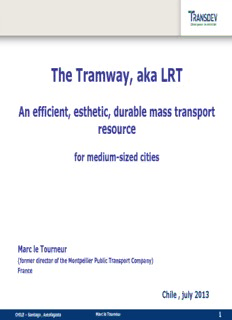Table Of ContentThe Tramway, aka LRT
An efficient, esthetic, durable mass transport
resource
for medium-sized cities
Marc le Tourneur
(former director of the Montpellier Public Transport Company)
France
Chile , july 2013
CHILE – Santiago , Antofagasta Marc le Tourneur 1
SUMMARY
1. The tram, a transport mode between BRT and metro
2. The tram (re)birth in France, a success story
France: Public Transport organization
28 new tram networks in 30 years
New trams, a revolution for Public Transport
Three causes for the tram success
3. The case of Montpellier: an exemple of a successful choice for tram
A rapidly growing city in Europe
Sustainable mobility: a global approach
Strong ties between city planning and Public Transport
Paid parking: first step in congestion charge
Pedestrian only zone in all historical center
The creation of a 4 tram lines network in 15 years
Integrated and intermodal Public Transport network
4. The Tramway/bus/BRT compared economic analysis in Montpellier
ANNEXES
1-Urban growth and public transport development
2-Tram line description
3-Figures
4-The case of Strasbourg
5-Examples of European trams
CHILE – Santiago , Antofagasta Marc le Tourneur
1. THE TRAMWAY BETWEEN BRT AND
METRO
In the world's major cities, mass transport comes down to a choice
between metro (Mass Rapid Transit) and BRT (Bus Rapid Transit).
New York's subway Bogota's TransMilenio
The tramway, whose revival dates from only the 1980s, appears as a
mode of transport that is:
Touristy and historic for the cities that have kept their old tramways
(San Francisco, Rio de Janeiro, New Orleans, etc.)
Esthetic and costly for the new tramways built generally in the richest
Rio de Janeiro's
countries
Bonde de Santa
Teresa
CHILE – Santiago , Antofagasta Marc le Tourneur 3
The modern tramway
(or Light Rail, or VLT, or light metro)
holds its place between the BRT and the metro
The capacity of the vehicles places the tram between buses and
metros:
articulated bus : 105 places (18m long) to 150 places (24m long)
tramway : 200 places (30m long) to 350 places (45m long)
metro : 300 to 1500 places, depending on the length of the
trains.
The total investment cost per kilometer for a complete line also
places the tram between BRT and metro:
BRT with new infrastructure : €5 to 15 M/km
tramway : €15 to 40 M/km
metro : €80 to 200 M/km.
The operating cost per kilometer traveled within the same
country places the tramway between bus and metro.
CHILE – Santiago , Antofagasta Marc le Tourneur 4
LRT, a large capacity mass transport resource
Istanbul
260,000 daily passengers
60 meters long
450 places
Montpellier
130,000 daily passengers
40 meters long
300 places
CHILE – Santiago , Antofagasta Marc le Tourneur
Increasing capacity : case of L1 in Montpellier
Tram length can be increased progressively. The higher the
capacity is the cheaper the system is per passenger.
CHILE – Santiago , Antofagasta Marc le Tourneur
In the countries of the OECD, the passenger transported in
a tramway often costs less than in a BRT over the lifetime
of the system
The total investment cost (infrastructures and vehicle) is 2 to 3
times higher.
But the operating savings permitted by the high capacity of the trains
and the efficiency of the railway vehicles offset the extra cost of
investment, over the entire depreciation term.
If, of course, the customer base is there!
The more the living standard of a country increases, the more the
economic advantage of the BRT compared to the tramway
decreases.
CHILE – Santiago , Antofagasta Marc le Tourneur 7
The cities involved in a tram project
Cities with 300,000 to 1,000,000 inhabitants are the best suited for the
implementation of a tram network on the principal traffic routes and the re-
organisation of their initial bus network.
The choice of the traffic routes to be equipped with a tram line is based on the
potential patronage:
For trams 30 meters long : 40 to 80,000 passenger per day
2,000 to 5,000 passenger per hour per direction
For trams 45 meters long : 80 to 160,000 passenger per day
3,000 to 10,000 passenger per hour per direction
For hinged trams 70 meters long : 120,000 to 240,000 passenger per day
6,000 to 14,000 passenger per hour per
direction
The Istanbul tram line, which is likely the world’s most frequented, carries 260,000
passengers per day exclusively at ground level.
Tram length can be increased progressively. The higher the capacity is the cheaper
the system is per passenger.
CHILE – Santiago , Antofagasta Marc le Tourneur
2 – THE TRAM (RE)BIRTH IN FRANCE
A SUCCESS STORY
Montpellier
Mulhouse
CHILE – Santiago , Antofagasta Marc le Tourneur
FRANCE: PUBLIC TRANSPORT ORGANIZATION
1. A local transport authority system (LTA)
. Area
. Competence
. Organization
2. The financial environnment
. Low traffic fares (30% operating cost)
. Special local tax for Public Transport (based on salaries) paid by
all public and private companies: « versement transport »
.Low national State subsidies
3. Contractual links between LTA and Operators
. Operating PPP contracts « Délégation de service public »
. Exclusive operating rights (usually)
. Multimodal and intermodal contractual relations (bus, tram,
P+R, all types of fares, bicycles, trains,…)
CHILE – Santiago , Antofagasta Marc le Tourneur
Description:The Tramway, aka LRT. An efficient, esthetic, durable mass transport resource for medium-sized cities. Marc le Tourneur. (former director of the

